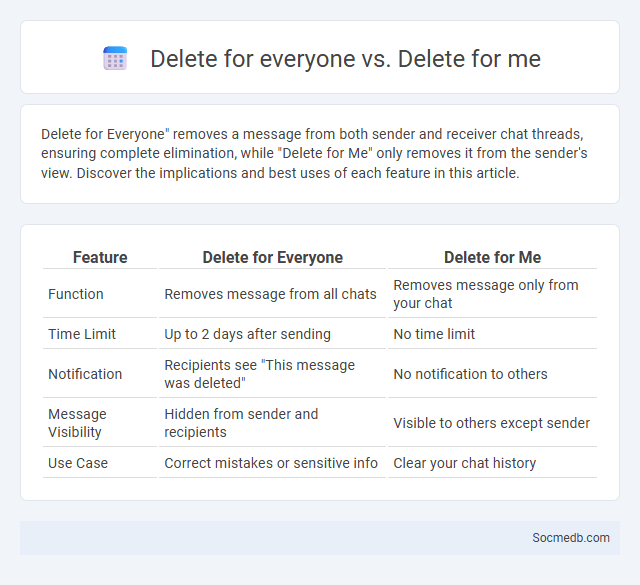
Photo illustration: Delete for Everyone vs Delete for Me
Delete for Everyone" removes a message from both sender and receiver chat threads, ensuring complete elimination, while "Delete for Me" only removes it from the sender's view. Discover the implications and best uses of each feature in this article.
Table of Comparison
| Feature | Delete for Everyone | Delete for Me |
|---|---|---|
| Function | Removes message from all chats | Removes message only from your chat |
| Time Limit | Up to 2 days after sending | No time limit |
| Notification | Recipients see "This message was deleted" | No notification to others |
| Message Visibility | Hidden from sender and recipients | Visible to others except sender |
| Use Case | Correct mistakes or sensitive info | Clear your chat history |
Understanding ‘Delete for Everyone’, ‘Delete for Me’, and ‘Revoke Message’
Understanding "Delete for Everyone" allows users to remove a sent message from both the sender's and recipient's chat, enhancing privacy by erasing content across devices. "Delete for Me" deletes the message only from the sender's device, leaving it visible to recipients, useful for decluttering personal chat history without affecting others. The "Revoke Message" feature commonly found in professional communication tools enables users to retract sent messages within a certain time frame, preventing potential miscommunication or data leakage.
Key Differences between Each Deletion Option
Social media platforms offer multiple account deletion options, including deactivation, temporary suspension, and permanent deletion, each differing in data retention and visibility. Deactivation typically hides the profile without erasing data, allowing users to reactivate later, whereas temporary suspension restricts access for a set period without data loss. Permanent deletion removes all user data and content irreversibly, ensuring complete account removal from the platform's servers.
How ‘Delete for Everyone’ Works
The 'Delete for Everyone' feature on social media platforms allows users to remove a sent message not only from their chat window but also from the recipient's conversation within a specific time frame. This function operates by sending a delete instruction to the platform's server, which then synchronizes the removal across all devices involved in the conversation. It enhances user control over their shared content, preventing unintended messages from being viewed and maintaining privacy.
The Functionality of ‘Delete for Me’
The 'Delete for Me' functionality on social media platforms allows users to remove messages or posts from their own view without affecting other participants' access. This feature enhances user control and privacy by enabling selective content management within conversations. It plays a crucial role in managing personal data and digital footprints across messaging apps like WhatsApp and Facebook Messenger.
What Does ‘Revoke Message’ Mean?
"Revoke Message" refers to the feature on social media platforms allowing users to delete or retract a sent message, making it no longer visible to recipients. This function enhances user control over their digital communication by enabling message removal after sending, often within a specified time frame. It is commonly found in messaging apps like WhatsApp, Instagram, and Facebook Messenger, promoting privacy and error correction.
Privacy Implications of Message Deletion
Message deletion on social media raises critical privacy implications, as deleted content may still be recoverable through backups or screenshots, compromising user confidentiality. You should be aware that platforms often retain metadata and logs even after message removal, potentially exposing sensitive information. Understanding these risks is essential for safeguarding your digital privacy when managing conversations online.
Time Limits and Restrictions for Each Option
Instagram enforces daily time limits through its "Your Activity" dashboard, allowing users to set reminders after predefined usage periods. TikTok offers customizable screen time management tools that enable users to schedule breaks and restrict app access during specified hours. Facebook provides activity tracking alongside options to mute notifications and set time limits, helping users control their daily engagement on the platform.
Scenarios for Using Each Delete Feature
Social media platforms offer tailored delete features designed for specific scenarios such as removing individual messages, deleting entire conversations, or erasing posts and comments. Users often delete messages to correct errors, protect privacy, or avoid misunderstandings, while deleting posts addresses outdated content, reputation management, or policy violations. Understanding when to use each delete function enhances content control and maintains digital safety across platforms like Facebook, Instagram, Twitter, and WhatsApp.
Limitations and Risks Involved
Social media platforms expose users to significant limitations such as privacy breaches, data misuse, and algorithm-driven echo chambers that constrain diverse viewpoints. The risks involved include cyberbullying, identity theft, and misinformation campaigns that can harm your reputation and mental health. Understanding these challenges is crucial for You to navigate social media safely and maintain control over Your digital presence.
Best Practices for Managing Deleted Messages
Efficiently managing deleted messages on social media involves regularly auditing message history to ensure compliance with privacy policies and data retention laws. Utilizing built-in platform features such as message recovery tools and archiving options helps maintain conversation integrity and supports dispute resolution. Implementing automated deletion schedules combined with clear documentation enhances security and trust among users.
 socmedb.com
socmedb.com